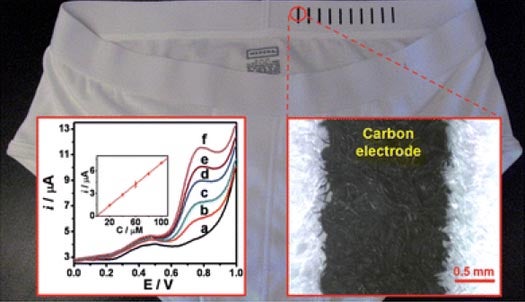Bio-Sensing Underwear Keeps Tabs on Your Body’s Chemistry
Finally, something to wear with your smart bio-watch: bio-sensing briefs with a strip of thick-film amperometric sensors printed right into...

Finally, something to wear with your smart bio-watch: bio-sensing briefs with a strip of thick-film amperometric sensors printed right into the waistband. Why sensors in your skivvies? Aside from finally getting a clear measurement of the peak foot-pound force created by a Level 5 Atomic Wedgie, a small strip of biosensors pressed directly against your skin could monitor the body for a variety of biomarkers and other indicators, alerting the wearer that something is amiss.
A collaboration of researchers in the U.S. and Taiwan devised the sensor strips, which are textile ready and can conform to the stresses and deformations normally endured by articles of clothing. Just to prove the idea feasible, the team created sensors for NADH and H2O2 and printed them directly into the elastic waistband of a pair of whitey-tighties.
The sensor bands were manufactured using conventional screen-printing technology along with a textile substrate. But rather than normal ink, the researchers printed carbon electrodes directly onto the elastic band. They then stretched, twisted, and bent the waistband every which way to see how it would hold up. By the time their trials were done, they’d found a fairly reliable means of printing carbon electrodes right onto the fabric without any cracking or peeling in a way that should hold up to everyday wear and tear.
Bio-sensing briefs could be especially handy for helping elderly people keep an eye on their physiological indicators, but could also find applications in sports and the military. While the proof-of-concept measures only for hydrogen peroxide and NADH, a range of sensing technologies could be built into a waistband, warning of heat stroke in athletes or dehydration in soldiers on the march.
Whether or not such an undergarment could warn you that you’re about to be hung up by your drawers remains to be seen.